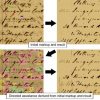CVPR
2009
IEEE
15 years 6 months ago
2009
IEEE
Ink-bleed interference is a serious problem that affects the legibility of old documents. Ink-bleed can be reduced reasonably well using pixel classification based on user supplie...
CVPR
2009
IEEE
15 years 6 months ago
2009
IEEE
In recent years, large databases of natural images have
become increasingly popular in the evaluation of face and
object recognition algorithms. However, Pinto et al. previously
...
CVPR
2009
IEEE
15 years 6 months ago
2009
IEEE
This paper discusses the question: Can we improve the recognition of objects by using their spatial context? We start from Bag-of-Words models and use the Pascal 2007 dataset. We u...
CVPR
2009
IEEE
15 years 7 months ago
2009
IEEE
We generalize reflection symmetry detection to a curved
glide-reflection symmetry detection problem. We propose
a unifying, local feature-based approach for curved glidereflectio...
CVPR
2009
IEEE
15 years 7 months ago
2009
IEEE
Global shape information is an effective top-down complement
to bottom-up figure-ground segmentation as well
as a useful constraint to avoid drift during adaptive tracking.
We p...
CVPR
2009
IEEE
15 years 7 months ago
2009
IEEE
A Bayesian marked point process (MPP) model is developed
to detect and count people in crowded scenes. The
model couples a spatial stochastic process governing number
and placem...
CVPR
2009
IEEE
15 years 7 months ago
2009
IEEE
Head pose and eye location estimation are two closely
related issues which refer to similar application areas. In
recent years, these problems have been studied individually
in ...
CVPR
2009
IEEE
15 years 7 months ago
2009
IEEE
We present a system for fast model-based segmentation and 3D pose
estimation of specular objects using appearance based specular
features. We use observed (a) specular reflection...
CVPR
2009
IEEE
15 years 7 months ago
2009
IEEE
The ability to constrain the geometry of deformable models for image segmentation can be useful when information about the expected shape or positioning of the objects in a scene i...
CVPR
2009
IEEE
15 years 7 months ago
2009
IEEE
Exaggerated defocus cannot be achieved with an ordinary compact digital camera because of its tiny sensor size, so taking pictures that draw the attention of a viewer to the subjec...



